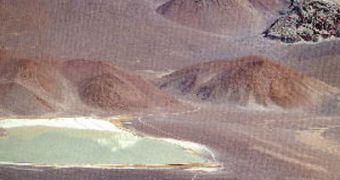In the South American Andes, it appears that volcanoes hold numerous surprises for researchers seeking unusual life forms, as evidenced by the fact that they have only recently discovered microbial colonies atop the 19,850-foot (6050-meter)-high Socompa volcano, located between Argentina and Chile. It would appear, they say, that the small creatures are “powered up” by gases and toxic fumes rising up from the volcano, in conditions that would kill a fully-grown human in a very short time.
According to University of Colorado-Boulder researcher Steve Schmidt, the microbial colonies manage to survive in conditions that are far worse than those that can be found in hydrothermal vents located at the bottom of the oceans. He adds that the complexity of the small ecosystems has had scientists puzzled, mostly because they have had no idea where the microbes got their energy from. After a while, they have figured out that water, carbon dioxide (CO2) and methane coming from within the ground are all used.
There is very little life on the high barren plateaus, other than these microbes. Researchers have thus far identified only tiny plants, which live in carpets around the volcanic vents. But even they have to endure the ever-prevailing cold, a thin atmosphere, low oxygen levels, increased ultraviolet radiation levels, and strong winds. Schmidt shares that the conditions closely resemble those on Mars, as far as some aspects go.
Analyzing these creatures in more detail could prove to be very useful in knowing what to look for on the Red Planet, as microbial filters become increasingly complex. No doubt, future Martian missions will be provided with such abilities, as astronomers theorize that at least some forms of Martian life may have survived the extreme chill and aridity of the planet.
“These sites are unique little oases in the vast, barren landscape of the Atacama Desert and are supported by gases from deep within the Earth. Scientists just haven’t been looking for microorganisms at these elevations, and when we did, we discovered some strange types found nowhere else on Earth,” Schmidt points out. “It's as if these bacterial communities are living in tiny, volcanic greenhouses,” CU-Boulder team member Elizabeth Costello concludes.

 14 DAY TRIAL //
14 DAY TRIAL //